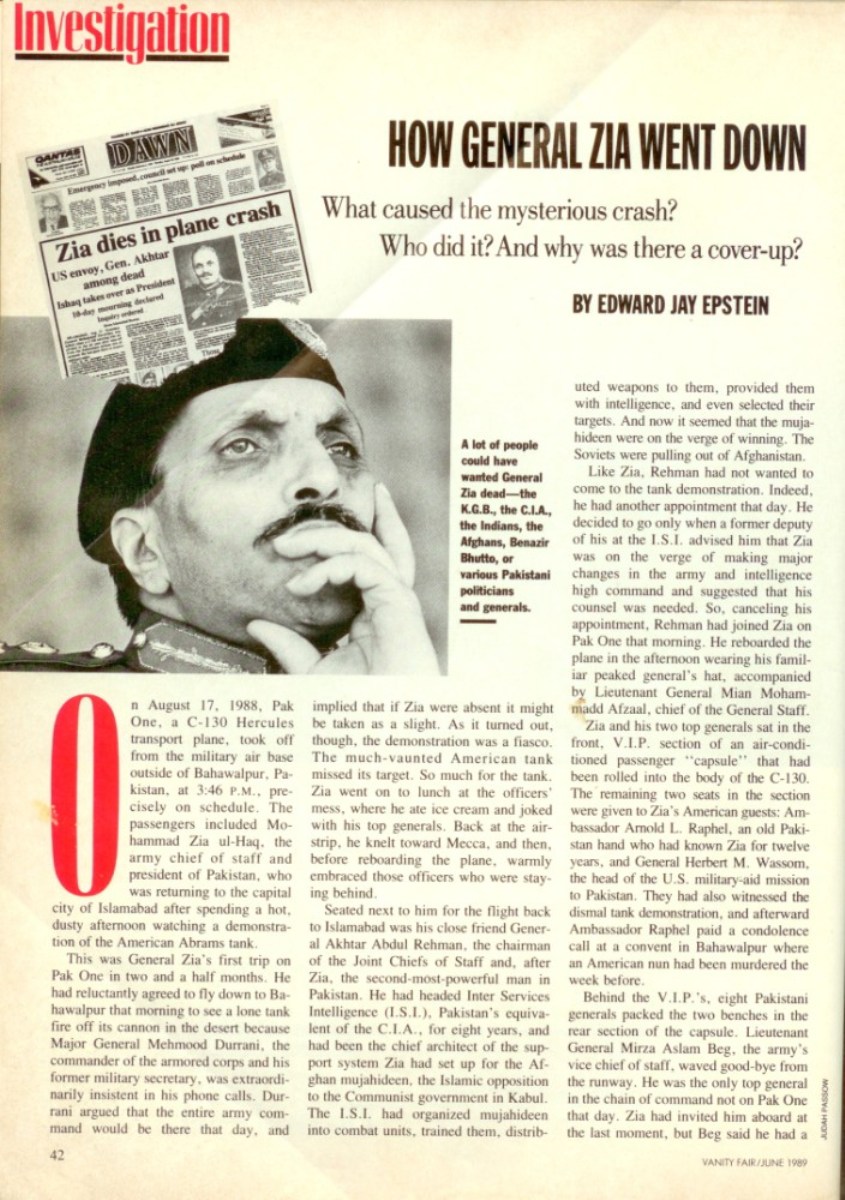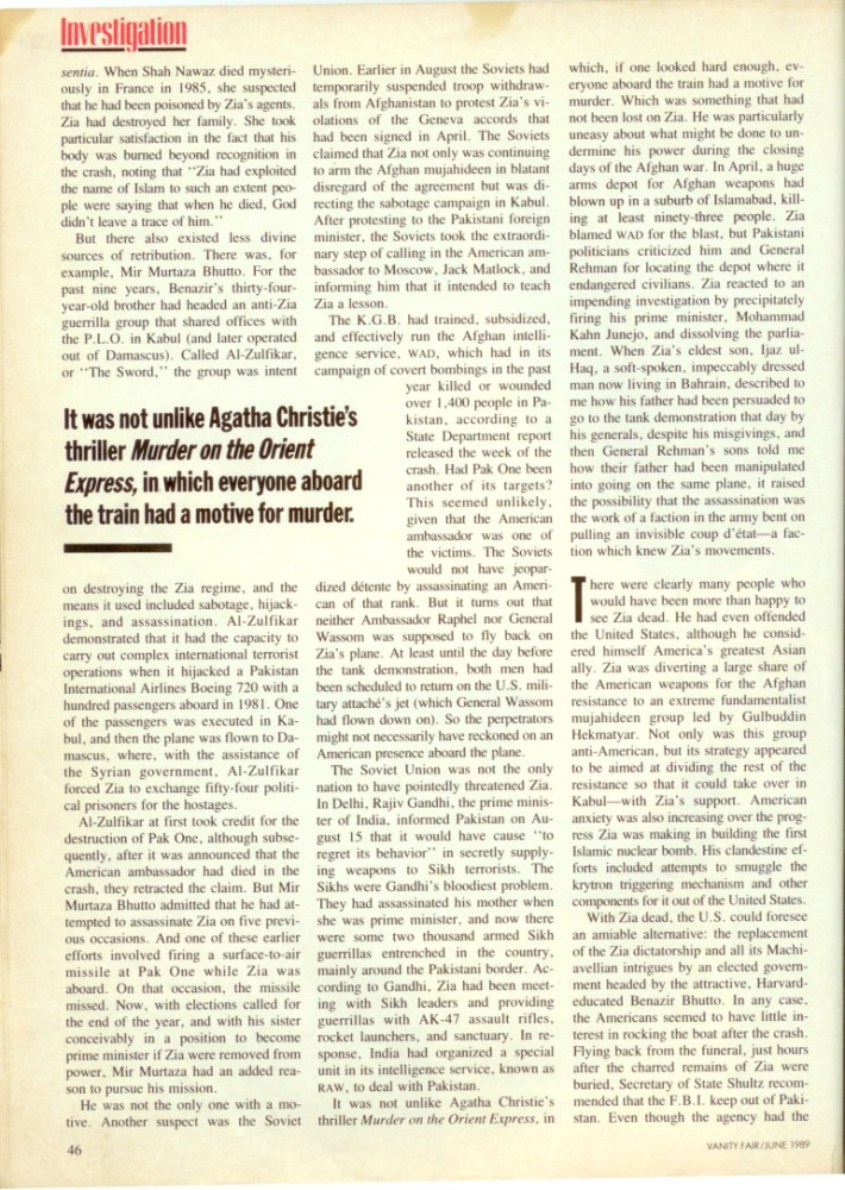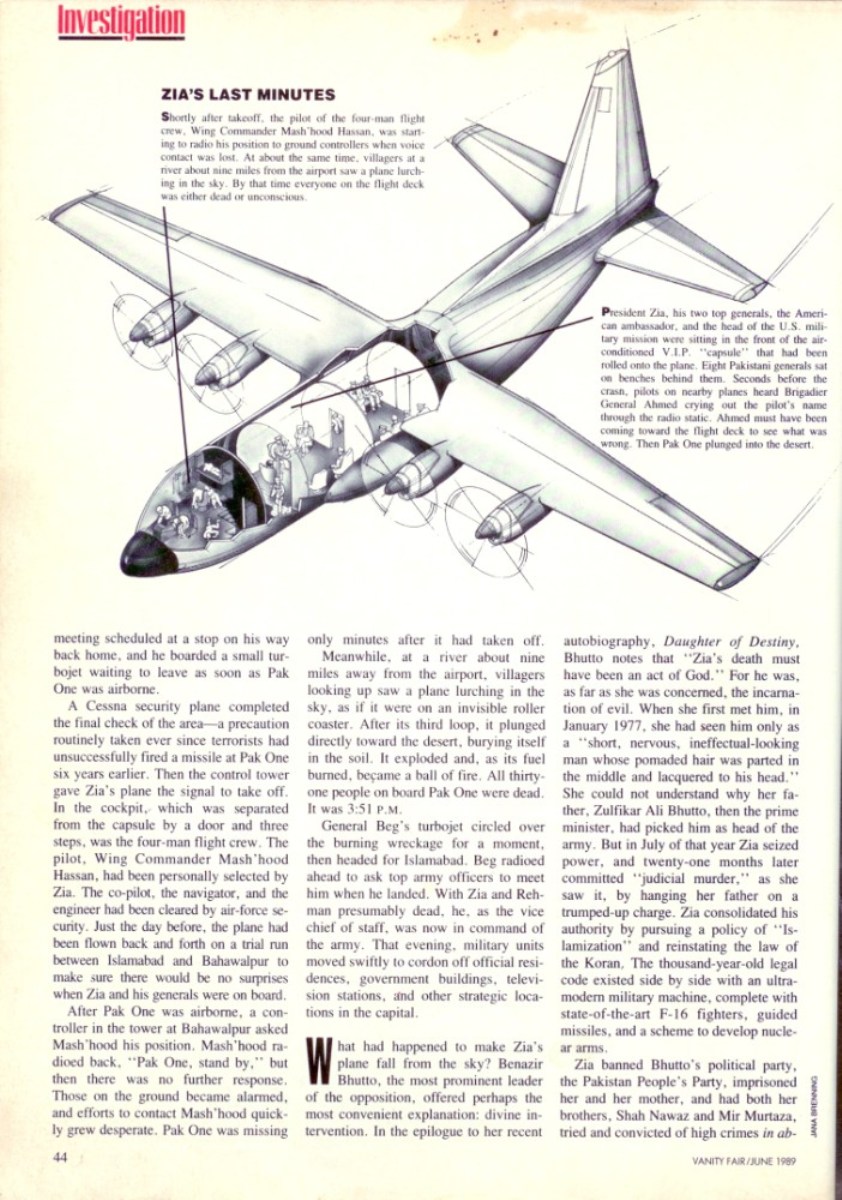This year marks the 24th death anniversary of General Zia-ul-Haq. His airplane called PAK-1 (Model C-130 Hercules) crashed on 17th August 1988 about 5 minutes after taking off from Bahawalpur (Zia had flown there to witness a US M1 Abrams tank demonstration).
Due to the unique geopolitical circumstances circumscribing Zia, he was afforded a long list of possible enmities that would surely have wanted him dead. To put things in perspective, he had been targeted on at least six previous occasions including an especially close shave with a missile fired at his plane.
To begin with, one of his most glaringly conspicuous enemies was the Bhutto family ever since he had made the choice to hang the then Prime Minister Zulfikar Ali Bhutto on 4th April 1979. He followed that by imprisoning Benazir Bhutto along with her mother, banning PPP and convicting Zulfikar’s sons Shah Nawaz and Mir Murtaza of harsh offences in absentia. Mir Murtaza, as a result, founded an anti-Zia terrorist group named Al-Zulfikar (The Sword) in Kabul where it shared offices with the PLO. Benazir even called the air crash ‘an act of God’.
Besides that, Zia was a man of military who upon entering politics would often brag that 'The Armed Forces are my constituency'. But even in military he didn’t have a lot of loyal associates mainly due to his special competence in identifying adversaries for clout and getting rid of them by dismissal or postings well away from the Islamabad and GHQ. Unsurprisingly, quite a few resentful Service chiefs were furtively delighted on his demise. In his book The Bear Trap, ISI’s Brigadier Mohammed Yousaf says that Zia was persuaded three days before (on 14 August) to attend this demonstration as a signature of goodwill to the US ally and goes on to make a rather weak case that this might have meant complicity of Pakistan’s top military brass.
However, his prospective slayers were not limited to the Pakistanis. From a geopolitical viewpoint, his death was especially significant for two key reasons. First off, he was the staunchest ally the Americans had fighting a covert war with Soviet on their behalf. This made Soviet along with CHAD (the Afghan secret police trained by the Soviet) his natural enemies. The Soviets were withdrawing from Afghanistan entirely because Zia had given sanctuary to the Mujahideen and had, for about nine years, been training and arming them in a bloodstained guerrilla war that had cost the Soviet military about 15,000 lives. Eduard Shevardnadze, the Soviet Union’s minister of foreign affairs, had publicly stated that Pakistan would pay profoundly for its support of the Mujahideen weeks before Zia’s death.
Secondly, Zia had furthered the bold initiative of acquiring a nuclear weapon taken by Zulfikar Ali Bhutto during his regime in response the nuclear test fire by India. As a result of that, tensions had escalated sky high as the two nuclear armed countries were at each other’s throats as India was rightly paranoid that Pakistan might launch an offence blaming India for the assassination. India even declared three day mourning for Zia’s death to diffuse the tension. When tensions are this high, perceptions rather than truth often determines the flow of events which in this case could have meant a bloody war.
In his book Ghost, Fred Burton (now working as Vice President for Counter Intelligence and Corporate Security at Stratfor) provides a compelling insight into the investigations jointly carried out by the Pakistanis and Americans which he was a part of as the senior investigator on behalf of Diplomatic Security Service (DSS) with Colonel Daniel Sowada leading the team from USAF. It was then DSS’ job to investigate the death of diplomat overseas and 2 Americans diplomats had also lost their lives in the crash. American Ambassador to Pakistan Arnold Lewis Raphel and Brigadier General Herbert M. Wassom, the head of the U.S. Military aid mission to Pakistan, both were aboard. A common misconception is that the two Americans were persuaded by Zia to accompany them as an insurance policy against such a calamity but this is debunked by Burton. Mel Harrison (US embassy’s Regional Security Officer) admitted to him that the American ambassador had swapped places with him on the final minute as he wanted an opportunity to discuss with General Zia about an attack on American nun and get some sort of assurance to punish the guilty.
The author highlights the mistrustful atmosphere that existed even then between the armed forces of Pakistan and US even after close collaboration between the two. He narrates a particularly interesting incident which I quote here:
“Gentlemen, please find a seat. We will give you full briefing.”
Cheech (A Pakistani military personnel he doesn’t refer to with his actual name but rather his likeness to Cheech Marin of Cheech and Chong movies) steps to a podium at the front of the room and surprises us with his first words.
“We have already solved the mystery. We know how PAK-1 went down.”… “This is a piece of PAK-1’s fuselage. Notice the hole in it?” He points to it and pauses again. “This proves a missile struck the C-130. This is the entry hole.”
… I can’t help myself. This is nonsense. I stand up and say, “There’s no way that hole was made by a missile.”
Cheech coldly responds, “Oh, What makes you think so?”
It is so obvious that I’m not sure how to be polite about it. “Well,” I begin, “if you look at the way the hole is torn in that piece from the fuselage, you’ll see whatever went through it went from inside to outside. That hole was made by something exiting the aircraft, not penetrating it.”
… I pick my pencil and tear a sheet of paper out of my notebook. I hold them both up and push the pencil through the paper. “See how the paper’s torn edges push outward from the hole I’ve just made? They follow the path of the pencil. Take a look at that piece of metal. See all the jagged pieces flowering out of the whole. They bent the wrong way for a missile hit. Something came out of the C-130 through that hole.
The investigation team started ruling out the different causes one by one. The weather was hot and clear and any chance of lightning striking the airplane was ruled out. The aircraft was fuelled at Chaklala Airbase and any possible contamination was checked for with the remaining fuel at the base and that ruled out too. Two crates of mangoes and couple of model aircraft were brought on board all of which were visually screened only. A bomb aboard, however, was also eliminated as an option due to the complete lack of any signature damage found in case of a bomb and also because of the relatively small wreckage radius. Moreover, the autopsy of Brigadier Wassom also showed that he had not inhaled any smoke and hence the absence of any large fire or onboard explosive.
A shepherd called Methuselah, witness to the final minutes before the crash, narrated to the team that the plane after flying straight for a short while started moving up and down mimicking the movement of a roller coaster which he said continued for several minutes until the crash. He also stated nothing from outside had hit the plane. Due to this statement and lack of any other credible evidence at the crash site, a missile hit was also crossed out by the team.
A minor inconvenience a team faced was the unavailability of the cockpit voice recorder since there wasn’t one installed in the airplane. The communication tower however testified that the correspondence with them was routine and the pilots had not issued a Mayday. On the other hand, the Cessna security plane, responsible for ensuring the security of the route ahead of PAK-1 did hear a momentary transmission from PAK-1 just before it crashed. Someone inside the aircraft had shouted “Mash’hood! Mash’hood!” The command pilot’s name was Wing Commander Mash’hood Hussain and was handpicked by General Zia to fly the airplane. The Wing Commander and the copilot were in top mental and physical condition to handle the flight so pilot error was not a possibility. The tower reported, however, that it was not the copilot and someone most likely from inside of the VIP suit had screamed. Possibility of a deliberate plane crash was also eliminated specially since flying the plane in vicissitudes is hardly the best way to go down.
So it eventually boiled down to one of the two things; either there was some sort of a mechanical disaster (electrical system functioned correctly till the end it was learnt) or someone had taken out both pilots before they could even manage a distress call. The auxiliary systems made into the Hercules can also for some very rough circumstances and an absolute loss of control due to the failure of one system or the other was rather implausible. Plus, the airplane had only flown less than 50 hours since a major overhaul. On the other hand, incapacitation of both pilots would even explain the absence of distress call which would have been certainly made had it only been a hydraulic or some other sort of technical failure giving pilots ample time to react.
Several chunks of the debris were sent to FBI for further examination due to insufficient examination facilities available in Pakistan. The striking conclusion the results led to was that the plane had not crashed because of a mechanical mishap.
Although some VIPs had arms with them none of which were found due to the severe intensity of fire after the crash but the cockpit also had no bullet holes (the bullet would have made it out from the other side at such close range). This was still a possibility but not plausible.
In the end, the truth was eventually disclosed by the ATF lab results. Their tests revealed traces of several sinister elements namely antimony, chlorine and phosphorous in the cockpit and also on a recovered mango seed. The rear cargo door also had traces of PNET, an explosive compound. I quote Fred Burton here:
Antimony. Phosphorous. Chlorine. All are ingredients in various types of nerve gas. One of the most deadly, VX, causes near-instant paralysis followed by death within seconds. Somebody planted nerve gas in the cockpit. This can only mean one thing: President Zia and his staff were assassinated.
… What was PNET doing on the cargo door, then? During their own investigation, the Pakistanis conclude that a small detonator had been aboard the plane. Attached either to a timer or a barometric pressure device, the detonator touched off a very-small-yield explosion, perhaps just big enough to blow the top of a Coke can placed on the flight deck. The interior of the C-130 is so loud I doubt anyone would have heard such a small pop.
But that’s what killed the pilots. When the detonator blew, it released the chemical agent into the flight deck. With the flight-deck door open, the small explosion blew enough particles into the rear of the aircraft to be detected on the cargo door.
The pilots never knew what hit them. The crash team determined that the pilots were not wearing their oxygen masks at the time of the crash. That fits with the low altitude the plane was at when the shepherd saw it oscillation through the sky. That rules out a poisoned oxygen system and lends much more weight to the Coke can theory posited by the Pakistanis.
I think they’re right. Now all that’s left is to figure out who did it.
He goes on to argue that at the time only three intelligence agencies had the capability to carry out such a sophisticated assassination; CIA, Mossad and the KGB. RAW was not deemed to have the capability to carry this out so neatly at the time.
Since Zia was America’s biggest Cold War ally next to Britain, the lack of motive gets them off the list. Due to the nuclear program, there was considerable tension between Zia and Israelis who had also taken out Iraq’s nuclear program in 1981 ‘with a stunning air raid that signaled to the rest of the Muslim world that Israel was prepared to go to any length to ensure that an Islamic country did not get the bomb.’ However, since Pakistan had already acquired full nuclear capability much before August 1988 (mainly due to the blind eye US had towards the Pakistanis in exchange for the Afghan war), killing Zia belatedly made little sense. That left the KGB.
The KGB had the motive i.e. payback, the history of using special chemicals for killing (Georgi Markov assassination), operational capability and may be through the help of Indian intelligence and CHAD officers combined with a very casual security at Bahawalpur or elsewhere (The Bear Trap puts forth the idea that the plant was made at Chaklala where access to C-130s for maintenance was routine) and the opportunity to carry this out.
Much about the intelligence agency responsible for carrying this assassination would have been left at only speculation had it not been for Colonel Sergei Tretyakov. He was the highest ranked officer to defect the SVR (ex-KGB) to the United States. In one of the most interesting leaks by Wikileaks of Stratfor emails shows that Colonel Tretyakov confirmed to none other than Fred Burton himself that KGB assassinated Zia-ul-Haq. Not only that, this assassination is taught as a case study at their intelligence academy.
Case closed.
Did the KGB killed Zia?










